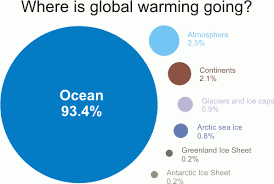The energy paths confronting the next two generations couldn't be starker. There is the "business as usual" case that assumes 4 degrees of global warming is inevitable, so we should use the cheapest and most plentiful energy sources available regardless of the fact that burning these fuels will raise atmospheric greenhouse gas concentrations 40 percent higher than current levels.
Then there is the off-the-shelf case that uses currently available technologies to reduce greenhouse gas emissions as rapidly as possible along a continuum between the current level and up to 560 parts per million (ppm), twice the preindustrial level, that produces average temperatures between 3 and 4 degrees higher than preindustrial levels depending on how rapidly the greenhouse levels can be brought down.
And finally there is the lowered ocean heat load case that reduces greenhouse gas emissions as rapidly as possible along the 400 to 560 ppm continuum, while reducing atmospheric and ocean surface temperatures one degree every decade, all the while producing as much energy as is derived by either the "off-the-shelf" approach or fossil fuels with the added benefits of reducing thermal ocean expansion and sea level rise, mitigating ocean acidification and producing potable water.
The 2008 paper, Irreversible climate change due to carbon dioxide emissions, by Solomon et al., says that the climate change that takes place due to increases in carbon dioxide concentration is largely irreversible for 1,000 years after emissions stop, due to the thermal inertia of the oceans.
Climate change is caused by heat trapped by greenhouse gases that produce an energy imbalance between the energy flowing in and out of the upper atmosphere. As shown in the classic skepticalscience.com visual for global warming components for the period 1993 to 2003, calculated from IPCC AR4 5.2.2.3, only 2.3% of this heat actually remains in the atmosphere.
By far most of the heat goes into the ocean and as James Hansen has suggested, "In my opinion, the rate of ocean heat storage is the most fundamental number for our understanding of long-term climate change."
The latest evidence put together by a team of Lawrence Livermore scientists lead by Peter Gleckler indicates two-thirds of this heat is accumulating in the upper 700 meters of the oceans, with another 15 percent below 2,000 meters, and 20 percent in between. Furthermore, the rate of this heat accumulation is ramping up with as much heat added in the past 18 years as was accumulated in the previous 133 years.
Because of their mass and heat capacity, oceans have thermal inertia. They are slow to heat and once warmed will be slow to cool down again.
On average they are about 1 or 2 degrees warmer than the atmosphere, so on average they transfer heat to the atmosphere, but this happens only at the surface so heat that has migrated below 700 meters, often considered the deep ocean, is essentially out thermal communication with the atmosphere as if had been sent into space. At least until such time as it can return to the surface at an average return rate of about 4 meters per year.
In a May 10, 2016, article, Almost Everything You Know About Climate Change Solutions Is Outdated, Part 1 , Joe Romm says climate science and climate politics have moved unexpectedly quickly toward a broad understanding that we need to keep total human-caused global warming as far as possible below 2 degrees C (3.6 degrees F) -- and ideally to no more than 1.5 degrees C. In the follow up, We Can Stop Searching For The Clean Energy Miracle. It's Already Here, ( May 12, 2016) he focused on what he claims is the light-speed changes in clean energy technology.
To hear Dr. Romm tell it, 1.5 degrees C is little more than a matter of political will and the adoption of the "off-the-shelf" technology, and we are good to go but that simply is not the case. James Hansen et al. debunked that myth in a 2005 paper, Earth's Energy Imbalance: Confirmation and Implications . The inertia of the oceans has already baked 0.6 degrees C -- 11 years later now closer to 0.7 degrees C -- into the climate system due to 37.5 years' worth of thermal inertia over and above the +1.22 0.14 temperature anomaly recorded by NOAA in March, 2016. We are already looking therefor at 2 degrees C in about 26 years with all of the best of political and technical intentions in the world. Not counting the 0.9 degrees Ramanathan and Feng have pointed to waiting in the form of hidden deferred warming from aerosols that will be 'unmasked' when fossil air pollution or fossil energy production stops and the likelihood of another 1.0 degrees C coming in the least time it will take to actually stabilize greenhouse emissions.
Probably, we are there for looking at closer to 4 degrees of warming.
Michael Mann in an April 1, 2014 Scientific American article Earth Will Cross the Climate Danger Threshold by 2036 essentially confirms Hansen's lag and says that if the world continues to burn fossil fuels at the current rate, global warming will rise by two degrees Celsius by 2036, which he says is the threshold above which human civilization is harmed.
The IPCC defines Equilibrium climate sensitivity as the change in global mean temperature that results when the climate system, or a climate model, attains a new equilibrium with the forcing change resulting from a doubling of the atmospheric CO2 concentration.
Knutti and Hegerl in the November, 2008 Natural Geoscience paper, The equilibrium sensitivity of the Earth's temperature to radiation changes, says various observations favor a climate sensitivity value of about 3 degrees C, with a likely range of about 2--4.5 degrees C per the following graphic whereas the current IPCC uncertainty is range is between 1.5 - 4.5 degrees C.
(Note: You can view every article as one long page if you sign up as an Advocate Member, or higher).






